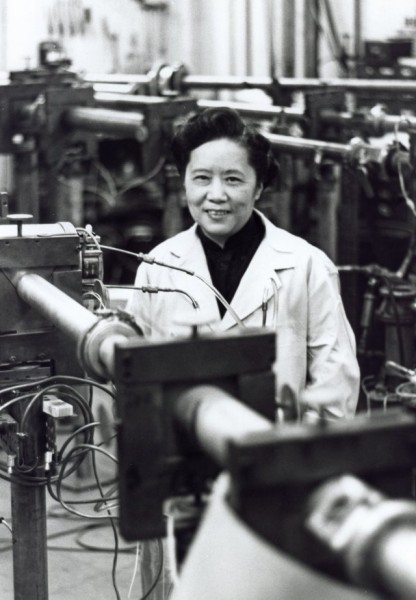As part of Asian Pacific American Heritage Month, the Lab pays tribute to physicist Chien-Shiung Wu, who has been called “the First Lady of Physics,” the “Chinese Madame Curie,” and the “Queen of Nuclear Research.” Wu worked with Ernest O. Lawrence and Emilio Segrè in the early 1940s, then spent most of her career at Columbia University.
 Chien-Shiung Wu arrived in Berkeley in 1936, on her way to graduate school at the University of Michigan to study physics. But she soon decided to stay in Berkeley—whether it was because she heard that women were not even allowed to use the front entrance at Michigan or because she was offered an opportunity to study under Ernest O. Lawrence is unclear.
Chien-Shiung Wu arrived in Berkeley in 1936, on her way to graduate school at the University of Michigan to study physics. But she soon decided to stay in Berkeley—whether it was because she heard that women were not even allowed to use the front entrance at Michigan or because she was offered an opportunity to study under Ernest O. Lawrence is unclear.
What is clear is that she went on to become one of the most renowned experimental physicists in the world. Her “Wu experiment,” proving an exception to the principle of conservation of parity, a fundamental law of physics, earned a Nobel Prize for her two male colleagues in 1957.
Wu’s story is one of many told in Headstrong: 52 Women Who Changed Science—and the World, a new book by journalist Rachel Swaby. In an interview with The Daily Beast, Swaby says she wrote the book partly to give girls role models in science.
“When girls are in elementary school they think they can be anyone, they can do anything. All of a sudden they get into high school, and they get into science classes, and besides the fact that they’re doing as well or better than the boys in the class, they’re looking toward their future, and they see posters full of male scientists. They don’t see themselves on the lab bench. They don’t see where their place is,” she said, citing an interview with a university official.
Wu worked closely with Emilio Segrè and finished her doctorate at UC Berkeley in 1940. She was unable to secure a position at the university so worked at the Radiation Laboratory (the precursor to Lawrence Berkeley National Laboratory) as a postdoc. She later worked on the Manhattan Project and eventually became a professor at Columbia University, where she stayed for more than 35 years.
In the 1950s her colleague Tsung-Dao Lee, also of Columbia, and Chen Ning Yang of Princeton came to her because they wanted to know if anyone had ever proven that the nucleus of a particle always behaves in a symmetrical way, which is known as the principle of conservation of parity and was accepted physics doctrine for 30 years. Wu devised an experiment, and after months of meticulous planning, she showed that, in certain cases, nuclei will give off more electrons in one direction than another.
Swaby describes Wu as a dedicated—even obsessed—scientist who would ask cabdrivers to swing by her lab on her way home from business trips just so she could glance at the windows. She is said to have said: “There is only one thing worse than coming home from the lab to a sink full of dirty dishes, and that is not going to the lab at all.”
In 1975, she became the first female president of the American Physical Society, the first non-white-male to serve in that position. She received the inaugural Wolf Prize in physics in 1978 for her explorations of the weak interaction. Wu died in 1997 at the age of 84.
Swaby’s book is available at the Berkeley Lab library.
-Julie Chao

Nowadays, from my own experience in conversations with many physicists, there is no doubt that she should have shared the Nobel prize with Lee and Yang. Her experiment was decisive, definitive, and of historical and fundamental importance. In my opinion, the fact that she did not share in the prize is a shameful page in the annals of physics
Thank you so much for sharing the story of Chien-Shiung Wu and her importance in the fields of Physics and Nuclear research. It’s essential that the contributions of women and people of color are recognized so that we all see the possibilities in STEM for everyone.
Wu’s talents were exemplary and her Lab connection is pretty cool.
Her “Wu experiment,” proving an exception to the principle of conservation of parity, a fundamental law of physics, earned a Nobel Prize for her two male colleagues in 1957. Did she not share the prize??